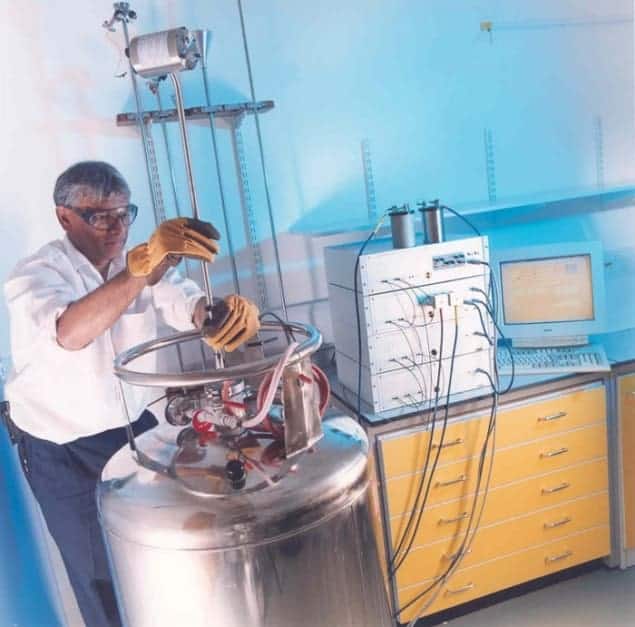
Researchers in the UK have produced the most accurate cryogenic current comparator – a device used for comparative measurement of current. The new instrument is more exact than previous designs and can, in principle, be operated without liquid helium.
From the picoamps of ionizing radiation delivered to cancerous tissue to the hundreds of amps traded by electricity suppliers, accurate measurement of electric current is vital to modern physics. The most accurate device to measure a direct current is a cryogenic current comparator (CCC). As the name implies, however, it can only operate at temperatures close to absolute zero, which can be problematic for laboratories without ready access to liquid helium.
Superconducting circuits
CCCs rely on superconducting materials and a quantum magnetic flux detector to measure current ratios. To measure an unknown electric current, two wires are passed through a tube of superconductor. An adjustable current is passed in the opposite direction to the current being measured, down one of the two wires. The current induced on the inside wall of the superconductor is equal and opposite to the difference between the currents. This current in turn completes a circuit with an equal and opposite current on the outside wall – a current used to induce a magnetic field measured by a superconducting quantum interference device (SQUID). When the SQUID measures zero magnetic field, there is no current in the superconductor, meaning the current in both wires is the same. Vastly different currents can be compared by adjusting the number of times that each current-carrying wire passes through the superconducting tube – so a current in amps can be compared to a current in picoamps, for example.
The cryogenic current comparator was first developed as a scientific instrument by Jonathan Williams and colleagues at the National Physical Laboratory (NPL), Teddington, UK, based on a German proposal. The first designs required a constant supply of liquid helium. This is manageable, if expensive, in physics laboratories in the developed world, but severely limits the commercial application of such devices in industry or in laboratories in developing countries.
Continuous cooling
More recently, mechanical refrigerators have been developed that cool to cryogenic temperatures using only electrical power. These are widely used in hospital MRI scanners to prevent the liquid helium boiling off. The new work has been carried out by scientists at the NPL along with colleagues at Cryogenic Ltd, a company based in London. The problem with the refrigerator, explains Cryogenic Ltd director Jeremy Good, is that the cooling is not continuous. “It’s a mechanical cooler,” he says, “It has a piston that moves up and down in a cylinder and provides refrigeration. But the end of the refrigerator goes up and down by about 0.6 K with a frequency of 1–2 Hz.” This would have a catastrophic effect on the accuracy of a measurement as SQUIDs and other components of a CCC are extremely sensitive to temperature and pressure.
Cryogenic has now developed a device to transmit the net cooling power of these mechanical refrigerators to the CCC while filtering out the oscillations and it hopes it will be possible to install a CCC that requires no input of liquid helium. “We think we can do it, but it is not proven,” says Good. Williams, who heads the electrical measurement side of the project at NPL, explains, “There isn’t a technical limit in terms of cooling power or anything like that. It’s just marrying the two components [the mechanical refrigerator and the CCC] together and making sure they’re compatible.”
The researchers point to two potential uses of a “dry” CCC in medicine and chemistry. The dose of ionizing radiation given to a cancer patient is sometimes calibrated by measuring the tiny electric current produced by the beam in an ionization chamber. At the other end of the scale, the drive towards renewable energy requires hundreds of amps of current to be transferred between countries. “They want to share power coming from Scotland, where you’ve got wind turbines, with Spain, which is solar,” says Williams, “and to shift this power around Europe they’re putting quite a lot of investment into DC links.”



